Jalandhar: The floods in Punjab following a surge in the Ravi, Beas and Sutlej rivers have killed over 26 people, displacing hundreds and affecting over 3 lakh hectares of crops.
The waters have submerged village after village and brought the state’s economy to a halt.
The Indian Meteorological Department (IMD) has predicted more rainfall in the next three days from August 31 to September 3 in Punjab, worrying farmers and locals, both.
Following heavy rain and a rise in the water level of Beas on August 31, the local administration issued an alert urging people to rush to safer locations. The Beas water level has now increased to 2.35 lakh cusec, deputy commissioner Amit Kumar Panchal said.
Week-long rains and cloudbursts in Himachal Pradesh, the Jammu region and in the catchment areas of Ravi, Beas, and Sutlej rivers – coupled with heavy discharge of water from Bhakra, Pong and Ranjit Sagar dams – led to the water levels surging in Punjab.
The floods have affected over 16 districts in Punjab out of which Gurdaspur, Amritsar, Tarn Taran, Pathankot, Kapurthala, Ferozepur, Fazilka, Hoshiarpur and parts of Mansa and Patiala near Ghaggar river are badly hit. The Punjab government has so far evacuated 11,330 people and set up 77 relief camps, sheltering 4729 flood affected people.
The floods in Punjab are also a grim reminder of the 1988 deluge, when water level in the villages had gone up to 12 feet, leaving people stranded on terraces and trees. As per an India Today archive report, during the 1988 Punjab floods, around 9,000 villages, out of the 12,989 in the state, were affected. Out of these, around 2,500 villages were completely marooned, leading to severe loss of lives and property. As per government records, 1,500 people were killed while 500 went missing in these floods.
The floods of 1988 have another dark chapter associated with them – the killing of Major General B.N. Kumar, the then chairperson of Bhakra Beas Management Board (BBMB). Kumar was shot dead by militants for his role in handling the floods, which the latter claimed was a man-made disaster.
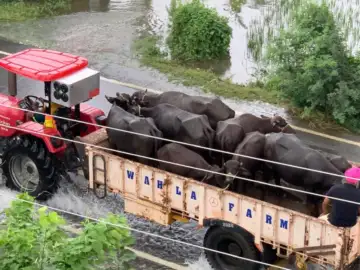 A villager rushing his livestock in tractor trolley in flood affected Gurdaspur district.
A villager rushing his livestock in tractor trolley in flood affected Gurdaspur district.
Committee and a request for a relief package
Punjab chief minister Bhagwant Mann has constituted a three-member committee to supervise flood relief and rescue operations. The committee comprising senior revenue, water resources and food and civil supplies department officers will be stationed at Amritsar to oversee the flood situation in affected border districts.
The chief minister also tasked the chief secretary to visit flood affected areas and ensure effective relief and rescue operations. “The heavy flow of water from hilly areas have created havoc in Punjab out of which 14.11 lakh cusec water was discharged in Ravi River till date. This is the highest discharge the state had ever received as it was 11.20 lakh cusec during the severe Punjab floods of 1988,” the CM stated in a press statement.
Similarly, the Army has been deployed at five flood affected districts while 17 teams of the National Disaster Relief Fund (NDRF) have also been deployed for relief operations. “The Punjab Mandi Board and PWD (B&R) have been asked to carry out a detailed survey of the extent of damage to the bridges, roads, and government buildings. Additional medical, sanitation and water supply teams have also been put to work to streamline the rescue operation,” Mann said.
Meanwhile, Punjab BJP president Sunil Jakhar on August 30 wrote a letter to prime minister Narendra Modi to provide central assistance to Punjab in the wake of massive damage. Leader of Opposition in the assembly, Partap Singh Bajwa also wrote separately to Modi for an urgent relief package.
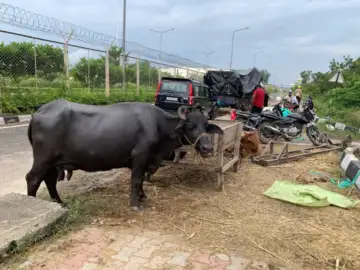 Villagers from Pakho Ke village situated on Kartarpur Gurdwara Highway in Dera Baba Nanak Stationed on the road after floods.
Villagers from Pakho Ke village situated on Kartarpur Gurdwara Highway in Dera Baba Nanak Stationed on the road after floods.
Over 3 lakh hectares of crops affected
Talking to The Wire, director of the Punjab Agriculture Department Jaswant Singh, said, “As per our estimate, around 3 lakh hectares of crops have been affected because of floods in Punjab. The Punjab government is yet to conduct ‘girdawari’, an official crop survey to officially assess the extent of damage,”
He pointed out that in Gurdaspur district, which is the worst affected, over 42,000 lakh hectares of paddy crop has been affected. “The water level in most of the villages in around 16 districts of Punjab – Gurdaspur, Tarn Taran, Pathankot, Kapurthala, Ferozepur, Fazilka, Hoshiarpur, Rupnagar was close to 8 to 10 feet, directly hitting normal life,” he added.
The director also mentioned that the flood situation in Punjab was grim and that there was prediction of heavy rainfall in the next three days from August 31 to September 2. “A lot depends on the rainfall in the next three days, after which we will be in a condition to assess the extent of loss to crops,” he said.
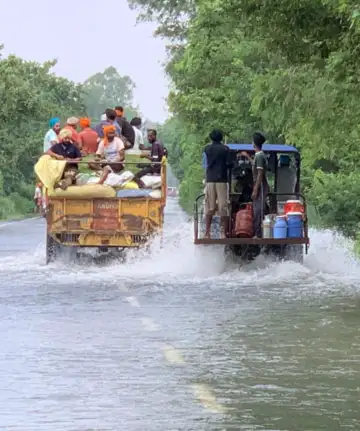 Villagers rushing in their vehicles to safer locations on Ajnala-Gurdaspur highway.
Villagers rushing in their vehicles to safer locations on Ajnala-Gurdaspur highway.
Fix accountability for devastating floods: Pandher
Sarwan Singh Pandher, the president of Amritsar-based Kisan Mazdoor Sangharsh Committee demanded an impartial probe by the AAP led Punjab government and the Union government into the Punjab floods.
“Will CM Bhagwant Mann raise this issue with the center government? Punjab did not face incessant rains, it was the heavy discharge of water from Bhakra, Pong and Ranjit Sagar dams that led to floods. The Punjab government should fix accountability for the devastating floods. Who asked the Dam officials to stop water earlier and then release it later?” he said, pointing out that prime minister Modi has not spoken a word about Punjab floods.
Pandher said that during these floods, 14.11 lakh cusecs of water was released into the Ravi river, submerging Gurdaspur, Amritsar and Pathankot districts. “As compared to this in the 1988 floods, only 11.20 lakh cusecs of water were released in Ravi. This time, the rains were less and the extent of water released was huge,” he said, demanding an investigation to study the data of last eight to 10 years of water released in Punjab rivers during floods.
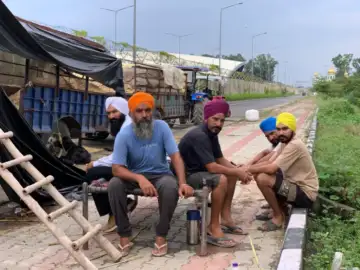 A family from Pakho Ke village situated on Kartarpur Gurdwara Highway in Dera Baba Nanak stationed on the roads after floods.
A family from Pakho Ke village situated on Kartarpur Gurdwara Highway in Dera Baba Nanak stationed on the roads after floods.
Farmers’ question Punjab’s drainage system maintenance
Agitated farmers and villagers questioned the AAP government for its preparedness to tackle the floods, when there were enough inputs by the Indian Meteorological Department (IMD) about rains in Punjab, Himachal Pradesh, and Jammu region.
“This time we want the Punjab government to fix accountability for the floods. We cannot let Punjab bear losses every alternate year because of man-made disasters,” said a farmer at Ajnala near the Indo-Pak border which has been severely affected by the overflowing Ravi.
A Punjab government official admitted that an inquiry into the Punjab’s drainage system is a must to ascertain the extent of loss and the reasons behind it. However, he refused to comment on the issue of maintenance and repair of the drainage system but said that all these factors would come to light only after the flood situation comes under control.
The Wire tried to reach out to the chief engineer of the canals department, Sher Singh, but he was not available for comment.
People spent nights on terrace:
In Gurdaspur district, which is close to the Indo-Pak border, around 324 villages have been severely affected because of floods. Helpless farmers in the flood-affected villages shared that their paddy, which would have been ready for harvest in a month’s time, was lost to the floods.
One such flood-hit village in Gurdaspur was Makora Pattan, situated on the zero line, where part of the fence dividing the Indo-Pak border was washed away by the heavy of Ravi.
A video from the Mehandipur village at the Khemkaran border of Tarn Taran district, showing a collapsed bridge, has gone viral.
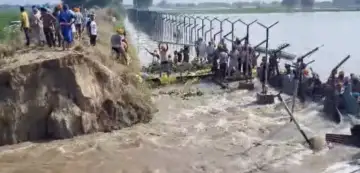 A screengrab.
A screengrab.
“As three rivers met at the junction of Makora Pattan – Ujh, Jalali and Ravi – it led to a surge in the river water flow resulting in flooding of all the villages,” said a villager from Bamiyal.
Similarly, people in Tur, Lassian, Jaidepur, Kajla, Bhagwal and Makhanpur villages situated on the international border in Gurdaspur were affected. The other flood affected villages include Jaidepur, Bamiyal, Bhagwal and Kohliya.
The Ajnala-Gurdaspur road and almost all villages along the Kartarpur Gurdwara Highway were severely affected as well. Around 400 students and staff of Navodaya Vidyalaya at Daburi in Gurdaspur were rescued from the waters by Khalsa Aid and Global Aid organisations.
At Pakho Ke and Haruwal villages in Dera Baba Nanak, villagers have been putting up tarpaulin tents along the Kartarpur Gurdwara highway. “My cauliflower fields, which I had taken on a Rs 80,000 annual contract, have been submerged in the floods. All our belongings have been ruined too. We are at the mercy of the almighty,” said Jaswant Singh from Pakho Ke village.
The farmers also lashed out at the Union government for not responding to the Punjab floods but acting strictly against them when it came to issues like stubble burning. “How come they cannot see our plight now?” asked Jaswinder Singh, a farmer from Dera Baba Nanak on the Indo-Pak border.
In Pathankot too, four villages on the zero line – Simbal Skol, Dhinde, Simbal Kuliya, Bhopalpur, Dhalotar – were marooned because of the overflowing Bhag river, a seasonal rivulet.
At Madhopur Headworks in rain-hit Pathankot district, the Army rescued 22 Central Reserve Police Force (CRPF) personnel and three civilians from a building, which was on the verge of collapse. Videos show a building collapse soon after the evacuation.
At Ahli Kalan and Khurd villages in Sultanpur Lodhi in Kapurthala district, water flooded paddy fields due to a breach in the advance embankment constructed in the Beas.
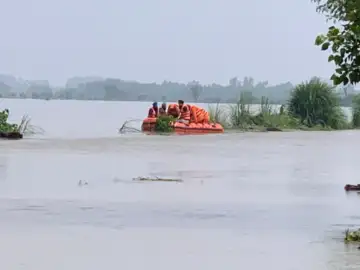
The boat of a rescue team stuck in the middle of a village flooded by overflowing Ravi River near Ajnala-Gurdaspur stretch.
Rajya Sabha MP Sant Balbir Singh Seechewal who has been overseeing rescue work in Sultanpur Lodhi for the past 20 days said, “The water level in Beas rose to 2.17 lakh cusec drowning around 50,000 to 60,000 acres of paddy crop in Sultanpur Lodhi alone.”
Villages affected in Sultanpur Lodhi of Kapurthala include Baupur Kadeem, Baupur Jadeed, Sangra, Rampur Gaura, Mand Bhim Kadeem, Mand Budhi Kadeem, and Mahummadabad.
In flood hit Ferozepur district, over a dozen villages including Mallan Wala, Nihala Lawera, Dhira Ghara, Rukne Wala, Gajni Wala, Kalu Wala, Bagge Wala, Muhammad Wala, and Nihala Kilcha have been affected.
Similarly, at Fazilka people in Pattan Post, Kawan Wali Pattan, Attu Wala Bridge, Gurka villages are dealing with rising water levels.
In Tarn Taran district too, many villages are affected including Kot Budha, Bhojoke, Jhuggian Pir Bakhsh, Radalke, Ram Singh Wala, Sabhra, Rasoolpur. “While at some places the water has receded, it will take months for us to come back to normal life,” said a group of farmers in Sabhra village.
Gurdwaras, Sikh groups providing relief material
Sikh groups, gurdwaras and Punjabi singers have also played important roles in the the rescue operation.
Sikh organizations like Khalsa Aid, Global Sikh Aid, United Sikhs, Sarbat Da Bhala Charitable Trust, and others were prominent in leading relief work.
Singers Jasbir Jassi, Ranjit Bawa, Resham Singh Anmol and Satinder Sartaj, through his Sartaj Foundation, were also running rescue work.Bawa who was on a world tour announced that he would donate the earnings from the show to the Punjab flood relief operation.
Farmers and youths from Punjab’s Malwa belt, which was relatively safe from floods, have been sending tractors loaded with ration, medicines and fodder for affected families. Farmer unions and Sikh organisations from Haryana have also been sending relief material.
